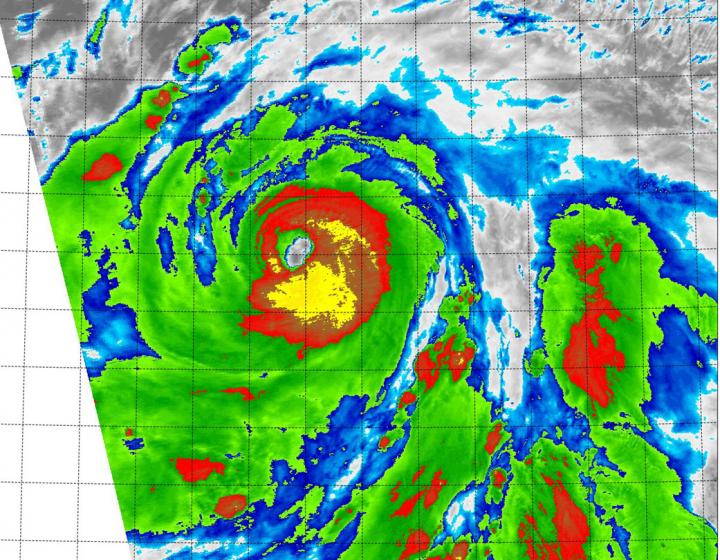NASA's Terra Satellite sees powerful storms ring Typhoon Atsani's eye

On Aug. 17 at 7:20 a.m. EDT the MODIS instrument aboard NASA's Terra satellite captured this infrared image strong storms (red and yellow) around Typhoon Atsani's center. Credits: NRL/NASA
Typhoon Atsani formed on August 14 as Tropical Depression 17W. By 2100 UTC (5 p.m. EDT) that day, 17W strengthened into a tropical depression was named Atsani. On August 16 at 0900 UTC (5 a.m. EDT), Atsani strengthened into a typhoon.
On Aug. 17 at 7:20 a.m. EDT (11:20 UTC) the Moderate Resolution Imaging Spectroradiometer or MODIS instrument aboard NASA's Terra satellite captured an infrared image of strong thunderstorms around Typhoon Atsani's eye.
The infrared imagery revealed very cold thunderstorm cloud tops with temperatures as cold as or colder than -63F/-53C. Cloud top temperatures that high indicate strong storms with the potential to drop heavy rainfall.
At 1500 UTC (11 a.m. EDT), on August 17, Typhoon Atsani had maximum sustained winds near 95 knots (109.3 mph/ 175.9 kph).
It was centered near 15.0 North latitude and 158.0 East longitude, about 358 nautical miles (412 miles/663 km) north-northwest of Ujelang. Atsani was moving to the north-northwest at 6 knots (6.9 mph/11.1 kph).
The Joint Typhoon Warning Center expects Atsani to move to the northwest and intensify up to 130 knots by August 20 before weakening again.
Media Contact
All latest news from the category: Earth Sciences
Earth Sciences (also referred to as Geosciences), which deals with basic issues surrounding our planet, plays a vital role in the area of energy and raw materials supply.
Earth Sciences comprises subjects such as geology, geography, geological informatics, paleontology, mineralogy, petrography, crystallography, geophysics, geodesy, glaciology, cartography, photogrammetry, meteorology and seismology, early-warning systems, earthquake research and polar research.
Newest articles

Security vulnerability in browser interface
… allows computer access via graphics card. Researchers at Graz University of Technology were successful with three different side-channel attacks on graphics cards via the WebGPU browser interface. The attacks…

A closer look at mechanochemistry
Ferdi Schüth and his team at the Max Planck Institut für Kohlenforschung in Mülheim/Germany have been studying the phenomena of mechanochemistry for several years. But what actually happens at the…

Severe Vulnerabilities Discovered in Software to Protect Internet Routing
A research team from the National Research Center for Applied Cybersecurity ATHENE led by Prof. Dr. Haya Schulmann has uncovered 18 vulnerabilities in crucial software components of Resource Public Key…




















